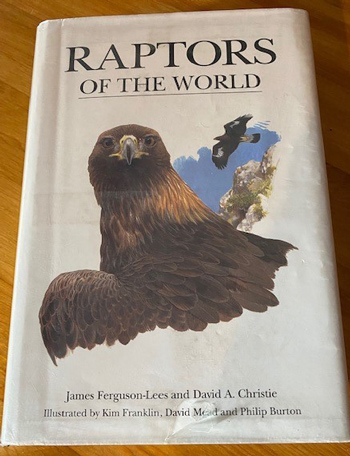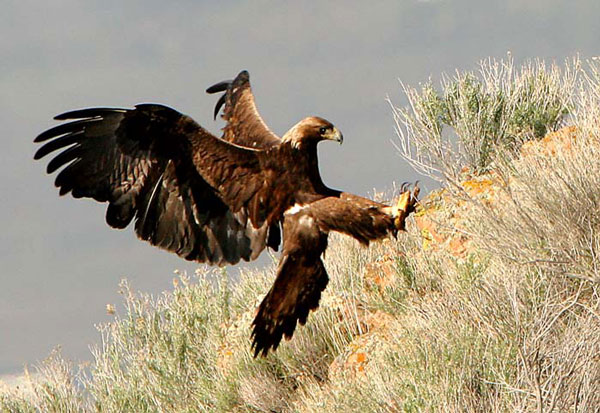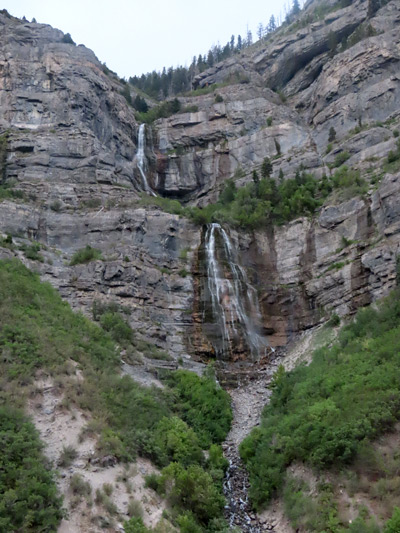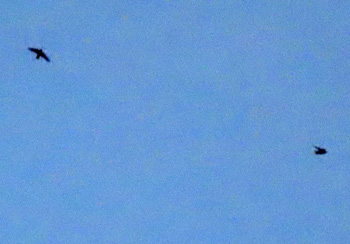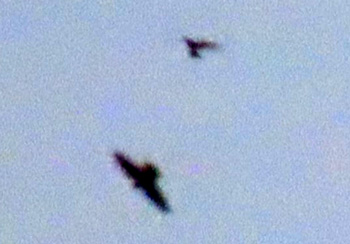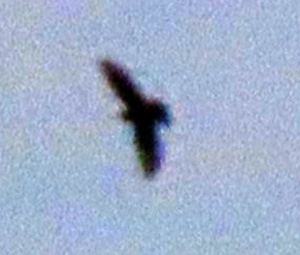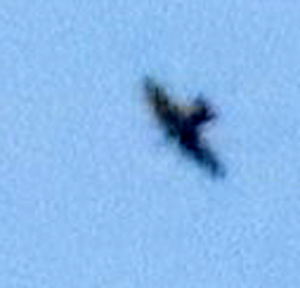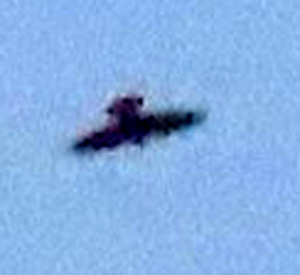|
August
2021
Contents
Monthly Meeting
Upcoming Field Trips
President's Message
Bird of the Month
Special Articles
Field Trip Reports
AUGUST MEETING:
Potluck Dinner
19 Aug 2021 - 6:30 PM
Thursday Aug 19th 6:30pm UCB Potluck dinner at Rock Canyon Park.
Bring a food item to share! There will be plenty of room to spread out and
enjoy each other’s company.
FIELD TRIPS:
|
Silver Lake & Lake Solitude Trail
Friday, August 6th, 7am
Friday, August 6 7am- noonish. Silver Lake and Lake
Solitude Trail. Meet at the AF Park and Ride at 7am and we will caravan up
to Silver Lake at the top of Big Cottonwood Canyon and gather in the Silver
Lake parking lot. We’ll bird the boardwalk around the lake and then hike a
short ways up the Lake Solitude trail looking for Williamson’s Sapsucker,
Red Crossbill, Thrushes, Rufous Hummingbirds and other species. Anyone who
doesn’t want to hike is welcome to stay down on the boardwalk and benches
around Silver Lake.
|
President's Message -
August 2021
by Machelle Johnson
Raptors of the World
Several years ago I bought this book at the Orem City
Library discard book sale. It cost me $1.50. The book is still in print and
available on Amazon from various sellers. The book was published in 2001, weighs
5 lbs and is 2.5 inches high! The Amazon description says: "Raptors is the first
complete identification guide to all the birds of prey of the world. Each of the
313 species is described thoroughly and accurately, and every plumage and
variation is shown in more than two thousand color illustrations plus hundreds
of black-and-white drawings. Both large-scale and small-scale range maps show in
detail where each species has been found."
I noticed that owls are not included in this book so I looked up the meaning of
raptor: "a bird of prey, e.g., an eagle, hawk, falcon, or owl." (google
dictionary) The word "raptor" comes from the Latin word rapere, which means "to
seize or take by force." "Raptor is a general term used informally to refer to
all birds of prey. Bird enthusiasts occasionally limit their use of the term
"raptor" to refer to birds of prey who hunt during the day. This separates them
from nocturnal birds of prey, like owls." (wonderopolis.org)
Did you know that there are such raptors as Buzzards, Honey Buzzards, atypical
Kites, true Kites, hawks of uncertain position, a Bat Hawk, true hawks and
buzzards, Falconets, Harpy Eagles, Aquila Eagles, Serpent Eagles, Hawk Eagles,
and just 1 type of Secretary Bird!?!
The current ABA checklist for North America shows 48 raptors, with 6 of those as
Accidental and 3 as Casual, leaving 32 as common, uncommon and rare.
"The ABA Area (sometimes referred to as the ABA Checklist Area) is essentially
North America north of Mexico plus the Hawaiian Islands. Specifically, the area
encompassed in the 49 continental United States, the Hawaiian islands, Canada,
the French islands of St. Pierre et Miguelon, and adjacent waters to a distance
of 200 miles from land or half the distance to a neighboring country, whichever
is less."
The
ABA list of raptors shows 3 New World Vultures, 1 Osprey, 7 Kites, 4
Accipitors, 4 Eagles, 1 Harrier, 16 Hawks, 10 Falcons, 1 Caracara and 1
Long-legged Buzzard (Accidental).
Comparing a few numbers from the ABA list to the Raptors of the World book,
there are 7 types of New World Vultures, 13 types of Harriers, 9 types of
Caracara's, dozens of accipiter's, falcons, eagles, hawks, and buzzards. There
is only 1 type of Osprey in the whole world.
Per Wikipedia: "The osprey is the second most widely distributed raptor species,
after the peregrine
falcon, and is one of only six land-birds with a cosmopolitan distribution.
It is found in temperate and tropical regions of all continents, except
Antarctica. In North
America it breeds from Alaska
and
Newfoundland south to the
Gulf
Coast and Florida,
wintering further south from the southern United States through to Argentina.[25]
It is found in summer throughout Europe north into Ireland, Scandinavia, Finland
and Great Britain though not Iceland, and winters in
North Africa.[26]
In Australia it is mainly
sedentary and found patchily around the coastline, though it is a
non-breeding visitor to eastern
Victoria and
Tasmania.[27]
"
|
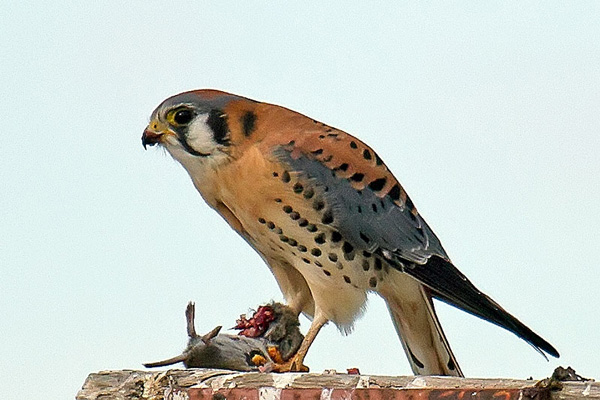
American Kestrel
by Kendall Brown
©Kendall W. Brown |
Now compare this to our
Utah checklist which shows 25 raptors with 4 of those as accidental: 2 New
World Vultures, 1 Osprey, 2 Kites, 3 Accipiter's, 2 Eagles, 1 Harrier, 9 Hawks,
5 Falcons. There is not a record of a Caracara or a Buzzard in Utah but almost
half of the raptors found in North America can or have been seen in Utah!
The scope of raptors is pretty amazing! You can certainly 'go down a rabbit
hole' with this book! There are pages and pages of raptors I've never heard of.
They are beautiful, strange and fierce! Leafing through this book reminds me of
a song that Dan Fogelberg wrote called 'The Higher You Climb": "The higher you
climb the more that you see, the more that you see the less that you know, the
less that you know the more that you yearn, the more that you yearn the higher
you climb. The farther you reach the more that you touch, the more that you
touch the fuller you feel, the fuller you feel the less that you need, the less
that you need the farther you reach."
I hope you're all able to get out and about and enjoy the summer and our
beautiful Utah!
Thanks,
Machelle
,__,
(0,0)
/)_)
""
Refrences
Google Dictionary
Wonderopolis
Raptors of the World By James
Ferguson-Lees, David A. Christie, Illustrated by Kim Franklin, David Mead,
Philip Burton
ABA Checklist
utahbirds.org, Utah checklist
Wikipedia
danfogelberg.com
|
|
BIRD OF THE MONTH:
|
|
|
|
The Capuchinbird
by Samantha Phillips
|
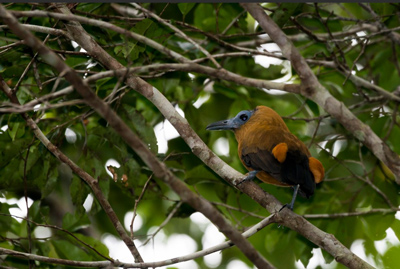
by
Claudia Brasileiro
©Claudia
Brasileiro
|
Imagine yourself trekking through the
humid lowland forests of the Guiana shield, on the northeastern coast of South
America. The trees around you are ringing with the sounds of the jungle at dawn,
confusing and cacophonous, but you are listening for something very
particular. Suddenly, from just above you, you hear a shockingly loud and nasal
wail, as though a cow has somehow been shrunk and transported into the treetops.
You look up and see the distinctive hunch-backed, bald-headed form of the
Capuchinbird, throat inflated and head thrown back in its peculiar song. As the
cry dies, away, you hear another, and after that another. You have found your
way to a lek, where these bizarre birds compete with their vocal talents to
attract the most mates. (watch
video)
One of the largest and undeniably oddest of the Cotinga family, the Capuchinbird
or Calfbird is an uncommon but unmistakable resident of the lowland rainforests
of Venezuela and the Guianas. The Capuchinbird’s short tail, unfeathered
blue-gray head, and heavy gray bill create a unique silhouette unlikely to be
confused with anything else. The plumage is a dull cinnamon above, darker on the
rump and brighter on the belly, with blackish wings and tail. The males of the
species possess long, curled, bright orange undertail coverts, which
are raised out like puffy “taillights” during the lekking display. The
feathering around the neck is dense and upraised, creating a cowled appearance
that contributes to the origin of the Capuchinbird’s name. Capuchinbirds are not
named after the monkey; rather, both it and the monkey are named for their
resemblance to the monks of the Order of Friars Minor Capuchin, distinguished by
their shaved heads and heavy brown hoods and cowls. The Capuchinbird is very
large for a cotinga, averaging 35cm long (almost the size of a prairie falcon).
|
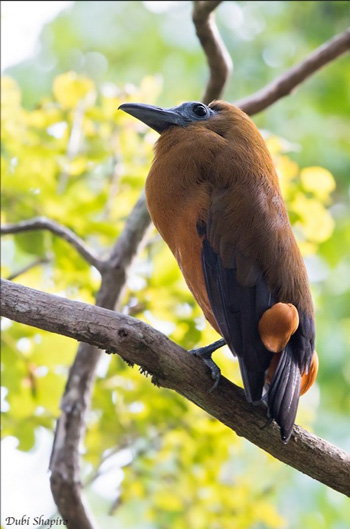
by
Dubi Shapiro
©Dubi
Shapiro
|
Although it is striking in appearance, the Capuchinbird’s
looks are not the strangest thing about it. The Capuchinbird engages in complex
breeding behavior centered around leks. Male birds gather in a central
location, referred to as the lek, and perform competitive displays for the
females watching from the sidelines. A single dominant male will usually control
the best display location, typically a bare branch with clear sightlines to the
waiting females. The subordinate males will display from the edges, fighting
among themselves and occasionally teaming up to attempt to oust the alpha from
his position. The male’s display is both visual and auditory. He stands upright,
raising his long curled undertail coverts to either side of
his tail. He leans forward and inhales air with a low growling sound, inflating
the resonant air sacs in his neck. He then lifts back up slowly into a tall
posture, puffing up his dense ruff of neck feathers and fanning out his short
tail as he calls out a loud, nasal “aaaaaa-OOOOOOOOOOOooo”. As the air sacs in
his throat vibrate with the call, the stretched skin shows transparent through
his feathers. Despite the competitive nature of the lekking displays, the males
at a lek appear to cooperate in one respect: they take turns singing, avoiding
overlap with their neighbors. Perhaps the females of the species prefer a
gentleman!
While the complex interactions of the leks have been well studied, the rest of
the life history of the Capuchinbird remains mysterious. The Capuchinbird tends
to be silent and solitary away from the lek, making it difficult to locate. It
feeds on both fruits and insects; hanging fruits are snatched from the branches
in flight, while insects are captured in short sallying flights like those of a
flycatcher. Females appear to nest close to leks and tend the nest and chicks on
their own with no help from the males. Sadly, the Capuchinbird appears to be
undergoing a slight but steady population decline, likely related to human
logging of its preferred lowland forests. It is, however, still rated as a
species of Least Concern by the IUCN.
|
-
|
|
|
Field Trip Reports
|
|
|
|
15 July 2020, Provo
Canyon
South Fork / Bridal Veil Falls
Field Trip
By Suzi Holt
We had a great turn
out for our South Fork/Bridal Veil Falls Overlook trip...Target bird Black
Swift! The weather was not the best, it was really windy!
We started at Vivian Park with lots of Barn,
Violet-green and Cliff Swallows and a few American Robins,
and a Cedar Waxwing. Then went up South Fork to a small residential
area and walked around. We saw 67 Wild Turkeys, Orange-crowned
Warbler, American and Lesser Goldfinch, American Robin's,
Broad-tailed Hummingbirds, heard a Cordilleran Flycatcher, Mourning
Dove, Pine Siskin, Turkey Vulture, Ravens, and a Cedar Waxwing.
We then headed to Bridal Veil Falls Overlook to look for the Black Swift.
The wind was still howling and dust was flying and there were hardly any
birds. We saw one White-throated Swift flyover and it gave good
looks, we heard a Swainson's Thrush, and American Dipper, saw
Robins and a couple high swallows and swifts. Around 8:20, we had a
group of 4 swifts flying high above the tree line in the clouds above the
falls. The wind calmed down considerably and we saw them well enough and we
were confident we had Black Swifts. They disappeared behind the
mountain to the east and reappeared along the ridge line to the east. They
were closer and with my 12x50 Binoculars and my camera I could not see any
white on them. The Black Swift is a large swift with a "cigar" shaped body
and pointed wings, they have slower wing beats and larger body size than the
White-throated Swift. We got some really zoomed in bad photos. I was sad
that the wind chased a few birders off early :(
|
|
|
|
|
|
|
If you have had any interesting
field trips on your own this month,
feel free to write a report for the newsletter!
(Send it to:
ucbirders@utahbirds.org)
|
|
|

